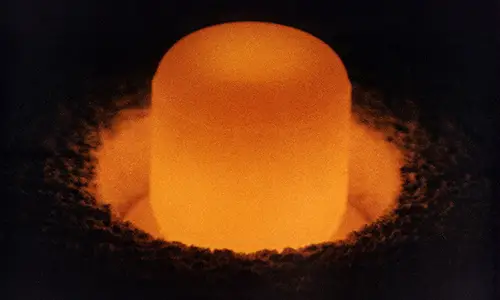• Discovery of Plutonium
It was summer of the year 1940 that Glen Seaborg, Arthur Wahl, and Joseph Kennedy, a team of chemists from the University of California, Berkeley, began their research for element 94. Neptunium was their first discovery. After a year, they became successful in their research by bombarding another element, uranium, to discover the element called plutonium.
• Plutonium (Pu)
Plutonium was the 94th element to be discovered. It is a man-made transuranic element discovered by researchers in Berkeley, USA. Plutonium-238 was the first isotope to be made, which is produced from uranium-238. Plutonium is an essential element for producing nuclear bombs, which is why it was said that the discovery of plutonium was a work of the devil.
• Fat Man
“Fat Man,” one of the nuclear bombs that helped end World War II, was a plutonium bomb. The bomb that was dropped in Nagasaki by an American bomber on August 9, 1945, weighed over 4,050 kilograms. It had a power equal to 22 kilotons of TNT and destroyed thousands of infrastructures. Thousands of people lost their lives, and those who survived were left damaged physically and mentally.
• Nuclear Fission Isotope
The process that makes plutonium destructive is called “nuclear fission.” The plutonium-239 is a fissionable isotope, which means that energy can be extracted from it under certain operations. Plutonium very rarely occurs naturally in nature; that’s why it is produced using breeder reactors, nowadays found in multiple countries. The longest-living isotope of plutonium is Pu-244, which exists for more than 82 million years.
• Name Derivation
Plutonium was named after our solar system’s once-called ninth planet—Pluto, the dwarf planet. Other elements that are also named after the planets in the solar system are uranium (Uranus) and neptunium (Neptune).
• Actinides
The “actinides,” also known as radioactive rare earth elements, are a series of elements found in Group 3 of the periodic table with the atomic numbers of 89 to 103. Plutonium is one of the actinides because it has an atomic number of 94. The most common actinides on the planet are uranium and thorium.
• Characteristics of Plutonium
Plutonium can be found in the third group of the periodic table. It has the symbol of “Pu” and an atomic number of 94, which means it must also have the same number of protons and electrons. Its melting point is 640.85°C, and its boiling point is 3,229.85°C.
• Plutonium Fuel
To keep a modern power plant running, it must burn a mixture of U-235 and U-238 (uranium isotopes) as its fuel. This is very wasteful in terms of preserving our natural resources, but economically it costs less than other sources of energy. As an alternative, power plants can use plutonium, which can be extracted from the burned uranium. It produces so much energy to fuel the power plants that the world’s uranium mining could stop for over 200 years while we use up the supply that is already mined and is just kept in storage.
• A Kilogram of Plutonium
Plutonium is one of the few elements that has extraordinary properties. With only a kilogram of plutonium, a massive explosion can be caused that is equal to the damage done by 20,000 tons of TNT. Also, a kilogram of this element can produce about 22 million kilowatt hours of heat energy.
• Transuranic
Plutonium is a radio-active and metallic transuranic element that can be seen as a silvery white metal. It has a density of 19.816 g and is usually extracted from uranium ore; that’s why it is called transuranic.











Leave a Reply